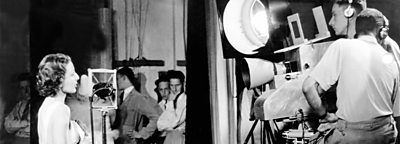In the summer of 1934, the government set up a committee, chaired by Lord Selsdon, to investigate the possibility of providing a high-definition television service to replace the low-definition 30-line transmissions already taking place. At that time Baird's improved mechanical television system had had the benefit of nearly ten years of development since its invention whilst the EMI electronic system was still in its infancy.
The picture quality of the two systems was similar, and so the Selsdon committee recommended that 'two television systems of High-Definition Television should be tried at the London Station'. The London Station was to be built and operated by the Βι¶ΉΤΌΕΔ, and the two systems (Baird and EMI) would broadcast on alternate weeks for a trial period of six months.
The government defined High-Definition as 'not having less than 240 lines per picture' and Baird set to work to increase his system to meet the 240 line threshold. At EMI, Isaac Shoenberg took the courageous decision to develop an electronic system which had 405 lines. This leap of faith, based on advice from his research team (over 60 strong), would have financially ruined the company had it failed.
The Baird Company set to work to design and build all the equipment for a complete television station, including the transmitters. EMI on the other hand felt that they didn't have the expertise in transmitter design, but they new a man who did - Guglielmo Marconi - so a new company, Marconi-EMI, was formed to deliver the entire electronic station.
Alexandra Palace
Meanwhile the Βι¶ΉΤΌΕΔ, tasked with providing a suitable building complete with the studios, sound transmitter, mast and aerials - all within 18 months - began a frantic search for a suitable site. Alexandra Palace, a run-down Victorian entertainments complex in North London, was not their first choice. However it had a couple of significant advantages - one, part of it was available for rent, and two, it was on top of a hill.
The Βι¶ΉΤΌΕΔ knew that it was vital to get the transmitting aerials as high as possible. Calculations showed that to get a reliable range of 25 miles reception with a 34 thousand watt transmitter; the aerial had to be about 600 feet (180 metres) above sea level. Alexandra Palace was already half that, so the transmitting tower only needed to be another 300 feet (90 metres) tall.
A year later, the building work was advanced enough for the two rival companies to start to move their equipment in. Each had their own studio and control room but shared facilities such as dressing rooms, scenery workshop and canteen. The summer of 1936 saw a hive of activity as everyone worked frantically towards the official opening date of early November - but all that was about to change.
Olympia broadcast
The 1936 Radio Show at Olympia was scheduled for the end of August. RadiOlympia was an annual exhibition put on by the Radio Manufacturers' Association, and a number of the exhibitors were displaying new television sets. Concerned that there would be no programmes to display on them at the show, the Βι¶ΉΤΌΕΔ came under pressure to provide demonstration transmissions during August. A variety show was quickly put together called 'Here's Looking At You', and it went out twice a day for two weeks, with the two competing television systems alternating on a daily basis.
Βι¶ΉΤΌΕΔ Television formally opened on 2 November 1936 at 3pm, with speeches by the Postmaster General, the Chairman of the Βι¶ΉΤΌΕΔ, and Lord Selsdon. The opening ceremony actually took place twice; first (on the toss of a coin) in front of the Baird cameras, and then again with the Marconi-EMI system. In this way, Βι¶ΉΤΌΕΔ television's second programme was also its first repeat.
The new Βι¶ΉΤΌΕΔ Television Service had started, and it was the first regularly scheduled true high-definition television service in the world. With the two systems alternating on a weekly basis, it was soon clear that Marconi-EMI were offering superior performance. The decision was taken to end the competition early, and after only three months the final Baird transmission went out at the end of January 1937.
The Βι¶ΉΤΌΕΔ 405-line television service was to continue (with a break during WWII) until the start of 1985, more than 48 years after the official start of the service.
